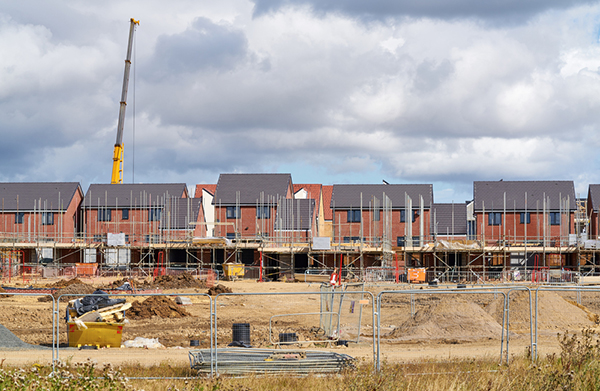Ten Things About HUD That Every Contractor Should Know

By Jade A. Craig, Cotney Construction Law.
Understanding HUD activities and programs helps contractors grow their business.
The U.S. Department of Housing and Urban Development (“HUD”) plays a critical role in protecting the foundation of the residential housing market as the insurer of loans for moderate-income single-family home buyers and for multifamily housing, including apartments and townhomes. Likewise, HUD distributes the federal funds that make up a large percentage of the budget that most state and local governments set aside for urban renewal projects and renovation efforts.
HUD programs and regulations affect every sector of the construction industry, yet many contractors are not aware of many of the Department’s programs and requirements or how they can leverage them to make their businesses more competitive. The initiatives and mandates below are among the efforts of HUD that are most relevant to a contractor’s business in the United States. These are programs every construction professional should watch as the agency’s priorities shift and its focus sharpens in response to the changing of the guard between the Obama and Trump Administrations.
- Section 3. The law that led to the creation of HUD more than fifty years ago included a provision that requires recipients of certain HUD funding, “to the greatest extent feasible,” to provide job training, employment, and contract opportunities to low or very low-income residents in the communities they serve. Section 3 residents are either public housing residents or low-income or very low-income individuals who live in the area where HUD funding is used. For example, construction companies that employ low-income individuals for local projects or participate in apprenticeship programs for at-risk youth would likely be compliant with Section 3 requirements. In addition, any business which is more than half-owned by Section 3 residents or which has a workforce of at least one-third Section 3 residents may be considered a Section 3 business. All recipients of HUD funding sources which are covered by Section 3, including state and local governments, property owners, and developers, must report their progress toward this goal every year. Since former presidential candidate and current HUD Secretary Ben Carson was confirmed in March 2017, he has expressed an interest in using the Section 3 mandate to improve access to job training in advance of the start date for major building projects in an effort to get local residents ready to work. This renewed focus on Section 3 may also lead to action on proposed regulatory changes to Section 3, which have been pending since March 2015. The proposed rule may provide the agency with the chance to address certain concerns in the construction industry, including changing the contract threshold requirement from $200,000 to $400,000, and the paperwork requirements, which many construction groups have indicated in public comments are burdensome and make compliance more difficult. Contractors can also make themselves more competitive in the bidding process by highlighting their efforts around hiring and training Section 3-eligible individuals or their status as Section 3 businesses. In fact, HUD has launched a registry to help its grant recipients find Section 3 businesses to hire as part of their efforts to comply with Section 3. If you believe your business is eligible, join over 20,000 businesses around the country and register at www.hud.gov/section3.
- The FHA 203(k) Program. The Federal Housing Administration (“FHA”) is a central part of HUD’s mission to increase home ownership in America. While the FHA does not serve as a lender or mortgage provider, it provides insurance for home loans issued to lower and moderate-income buyers. Section 203(k) insurance helps homebuyers and homeowners receive mortgages which support the purchase (or refinancing) of a house or mortgages which finance the rehabilitation of their existing home. Homebuyers and homeowners who receive standard Section 203(k)-insured loans must work with an approved consultant. Approved consultants must have (a) a minimum of three years of experience as a home inspector, remodeling contractor or general contractor; (b) meet state licensing requirements; and (c) be able to conduct feasibility studies, review or prepare architectural drawings, use proper methods of cost estimating, prepare change orders, and complete draw inspections, depending on the scope of his/her license. At the outset of the project, lenders assign consultants to assist borrowers in planning the work and developing cost estimates, and the consultant’s fee is included in the financing of the loan. HUD requires builders to apply for approval through the HUD Home Ownership Center closest to where they do business.
- Additional wage and hour requirements for HUD-funded projects. Most contractors are familiar with the Davis-Bacon Act, which requires contractors and subcontractors to pay laborers and mechanics who work on projects that receive certain federal financial assistance no less than the locally prevailing wages and fringe benefits for corresponding work on similar projects in their area. HUD, along with the Department of Labor, also require compliance with several other laws related to employee compensation. For example, the Contract Work Hours and Safety Standards Act (“CWHSSA”) applies to federal and federally assisted construction contracts for more than $100,000, and requires contractors and subcontractors on covered contracts to pay laborers and mechanics one and one-half times their basic rate of pay for all hours worked over 40 in a seven-day workweek. The CWHSSA also prohibits unsanitary, hazardous, or dangerous working conditions on these projects. In November 2015, President Obama signed into law provisions that allow the civil penalties available under certain labor laws, including the CWHSSA, to be adjusted for inflation. In August 2016, the civil penalty for violating the CWHSSA were increased from $10 per workday to $25 per workday. Contractors who work on federally-assisted projects should remain abreast of developments regarding applicable wage and hour laws to ensure they are in compliance with their obligations.
- HUD finances and regulates more than just housing. HUD insures mortgages for the development of a variety of health care facilities, including hospitals and nursing homes. Section 242 of the National Housing Act authorizes HUD to manage the Hospital Mortgage Insurance Program. HUD’s Office of Healthcare Programs oversees every aspect of the hospital construction process for properties built with FHA-insured loans. Contracts must include certain provisions, including compliance with federal labor standards laws such as the Copeland Act, which prohibits any federal building contractor or subcontractor from forcing an employee to give up any part of his/her compensation as a kickback to the contractor or a government official, and the Davis-Bacon Act, as well as assurances of non-discrimination in employment for all contractors, subcontractors, and vendors. General contractors must meet the agency’s pre-qualification requirements to participate in the mandatory bidding process for construction contracts. Likewise, construction managers must meet specific requirements regarding their capability and experience in engineering, budgeting, cost estimating, scheduling, purchasing, quality control, cooperation with architects during the early phases of design, and labor relations. Partnership with a team that understands HUD’s regulations and guidelines can be critical to the success of these kinds of projects.
- HUD financing for multifamily housing. HUD-insured loans for apartment complexes and other multifamily housing developments carry with them very specific documentation requirements regarding budgets, scheduling, cost reviews, construction close-out, payments, and bonding. The general contractor and owner will be required to complete a cost certification at the end of construction. The general contractor must also provide a 100% performance and payment bond (or 15-20% cash escrow or letter of credit acceptable to FHA), and have liquid net worth equal to at least 5% of the project construction contract plus all other uncompleted construction work. Indeed, shifts in FHA policies around ensuring home loans and HUD’s multifamily housing requirements policies can serve as a canary in the coal mine to builders who focus on serving entry-level borrowers. Delays in the processing of loan applications by the FHA can lead to delays in construction schedules, and changes to multifamily housing requirements can have a ripple effect throughout the project planning process. HUD’s processes have become more streamlined over the years, but they still require significant guidance.
- RAD Program. In 2012, Congress authorized the Rental Assistance Demonstration (“RAD”) Program to preserve and improve the nation’s public housing stock, which faces a $26 billion backlog in deferred maintenance. The RAD Program allows public housing authorities to convert their public housing stock to long-term Section 8 contracts and to leverage public and private debt and equity financing to renovate, rehabilitate, demolish, or build their properties. The contracts must be renewed every year with the same use restrictions so that they always remain affordable to low-income households. As of May 2017, more than 61,000 public housing units have been converted to Section 8, the first stage of preparing them for rehabilitation with private funding. RAD has stimulated $4 billion in construction improvements, with an average of $61,000 invested in construction per unit. HUD also estimates that RAD has led to the creation of more than 75,000 jobs across the United States. Currently, only 225,000 public housing units may be converted under RAD. However, Congress has steadily increased the number of units that the Department is allowed to convert, and President Trump has proposed removing the cap entirely in his 2018 budget for HUD. As of today, there are more than 76,000 public housing units awaiting conversion. As public housing authorities develop plans to revitalize their affordable housing stock, contractors and builders should keep an eye on this program and the opportunities that it opens up.
- Builders and the Fair Housing Act. The Fair Housing Act of 1968 established that “t is the policy of the United States to provide, within constitutional limitations, for fair housing” throughout the country. The law required that the federal government and recipients of federal funding must not only avoid residential segregation, but that they must “affirmatively further” what Congress and the U.S. Supreme Court have described as “truly integrated and balanced living patterns.” HUD’s Office of Fair Housing and Equal Opportunity (“FHEO”) is charged with enforcing the Fair Housing Act. FHEO is one of the nation’s largest federal civil rights agencies, with more than 600 employees in over 50 offices nationwide. For much of HUD’s history, it has had difficulty figuring out how to enforce the “affirmatively further” fair housing (“AFFH”) requirement of the Act. In August 2015, the Obama Administration strengthened the rules by requiring state and local governments that receive HUD funding to complete an Assessment of Fair Housing, a largely online tool that would guide jurisdictions through thinking about barriers to fair housing faced by groups protected under the Act in their community and challenging them to devise strategies to overcome these barriers. On January 5, 2018, the Trump Administration formally announced that it intends to suspend implementation of the AFFH Rule until October 2020, reportedly due to concerns that the online tool needed improvements so that it was easier for funding recipients to complete. Many civil rights groups, however, worry that this suspension will lead to eventually overturning or significantly altering the requirement entirely. It may also provide the HUD with the opportunity to revise the Rule to address persistent concerns that opponents have had about its impact on local land use decisions and the rights of landlords to decline to accept rental subsidies. Last year, Republicans in both houses of Congress proposed legislation designed to roll back the AFFH requirement in the Act or block HUD’s ability to enforce it, but, at this point, none have passed or been brought up for a vote. On the ground, the suspension will likely return local government efforts to reduce residential segregation to the status quo. Nonetheless, several related forces may still affect home builders. Many local governments have announced their intention to continue with their AFFH efforts despite the suspension. For example, Los Angeles, New Orleans and Seattle have all committed to increasing access to affordable housing in high-opportunity neighbors. As a result, they and other cities who follow suit will likely seek to work with home builders who have experience with using low-income housing tax credits in high-opportunity neighborhoods. The same cities have all made some commitment to preserving their current affordable rental housing stock, which may accelerate opportunities for home renovation and rehabilitation professionals as at-risk homes or multifamily complexes are revitalized. It appears that the AFFH Rule has led at least some cities to consider more nuanced approaches to integrated housing in favor of measures that may be more controversial and harder to administer, which opponents have long feared.
- Small Area Fair Market Rent Policies and Their Effect on Builders. In November 2016, HUD issued a rule which changed the method for determining “fair market rents” for Section 8 recipients. Section 8, which is one of HUD’s largest programs, provides vouchers to assist more than 2.2 million low and moderate-income families in covering the cost of rental housing. The law determines how much voucher assistance families may receive based on a formula set by HUD, which analyzes the average rental housing rates in a given area. Under the previous rule, fair market rents, “FMRs,” were the same amount across entire metropolitan regions. Under this standard, Section 8 voucher holders were typically limited to finding housing in properties where the rent was within the FMR limit, which usually limited them to living in low-income and low-opportunity neighborhoods. The Obama Administration’s new rule set FMRs based on ZIP codes, which the rule describes as “small areas.” Under this formulation, vouchers would cover more of the cost in higher-income and high-opportunity neighborhoods. The FMR rule became the mandatory method of calculation for 23 large metropolitan areas, in addition to the Dallas-Plano-Irving metro area, which had implemented the requirement earlier as a result of a litigation settlement. The rule was set to go into effect on January 1, 2018, but in August 2017, the Trump Administration notified more than 200 public housing authorities (which implement the Section 8 program in most regions) that it would be postponing mandatory implementation of the rule by two years. On November 8, 2017, Open Communities Alliance, a Connecticut-based advocacy group and along with two individual Section 8 voucher holders filed a lawsuit to prevent the delay and to keep the 2018 implementation date. On December 23, a federal trial court in Washington, DC, sided with the plaintiffs. The court determined that, as a matter of law, HUD had not followed the required procedures for suspending the regulation, and as a result, the January 1, 2018 implementation date remained in effect. HUD agreed to move forward with implementing the Small Area FMR program and the parties reached a settlement which ended the case in February. Several civil rights groups are considering mounting a similar legal challenge to the suspension of the AFFH Rule described above. It may prove challenging for HUD to ensure that costs are controlled under the new Small Area FMR mandate so that the change does not result in fewer households receiving assistance. This possibility is even more likely given the significant cuts that the Trump Administration has proposed for the Housing Choice Voucher Program in HUD’s FY 2018 budget. Nonetheless, the inconsistency may speak to a possible trade-off of providing fewer families with assistance to move into higher income neighborhoods rather than providing the same or less families with housing vouchers that have been, in practice, largely limited to low-income areas.
- HUD and Disaster Recovery. HUD manages and distributes most of the money that the federal government sets aside for disaster recovery. The Community Development Block Grant (“CDBG”) Program provides a total of $3 billion every year to more than 1,200 state and local governments around the country and allows them to determine how best to use the funds to develop their communities as long as they follow broad guidelines. The CDBG Program includes several supplemental programs under its umbrella, and one of the most important programs for the construction industry is CDBG Disaster Recovery (“CDBG-DR”). Congress created CDBG-DR in 1993 to supplement funds from other federal disaster relief programs. Since that time, CDBG has provided major funding for recovery efforts, including the aftermath of the September 11th attacks and following Hurricanes Katrina, Wilma and Sandy. As of August 2017, $47.7 billion has been allocated to CDBG-DR. Congress has also authorized HUD to distribute an additional $7.4 billion for disaster recovery for all of the disasters through the end of 2017, including Hurricanes Harvey, Irma, and Maria, as well as the California wildfires. While experts have indicated that funding for CDBG has declined since the program began in the 1970s and has failed to keep pace with inflation, CDBG-DR funds have far outpaced funding for the overall CDBG program. The needs are expected to grow as communities around the country face the challenges of climate change and the prediction that natural disasters may continue to increase in severity.
- Housing for the Elderly. Through the Section 202 Supportive Housing for the Elderly Program, HUD provides capital advances to finance the construction, rehabilitation, or acquisition of properties that will provide supportive housing services for very low-income elderly persons, along with rent subsidies to keep the properties affordable. The Trump Administration’s 2018 budget proposes to increase funding for this program as one of the Department’s key priorities. Earlier this year, the U.S. House and Senate proposed to increase funding for the program by $71 million, making it one of the few HUD programs for which Congress intends to increase spending rather than to freeze or decrease it. Only private nonprofit organizations may apply for funding, and the program is not open to state and local governments. Many of the largest providers of affordable housing for seniors rely on Section 202 funding, and some have partnered with health care entities to build communities that are designed to more effectively assist patients with chronic illness and to share healthcare personnel. As increased funding rolls out for this program, builders should follow opportunities to participate in the new construction and rehabilitation of these properties for seniors.
HUD’s mission of providing quality affordable housing and building strong communities goes hand in hand with the work of builders and contractors who specialize in building residential properties and public spaces and services. HUD’s priorities drive the funding that allows builders to do their work and opens doors for contractors to expand and develop their operations in certain areas. Builders and contractors should work with their attorneys to follow developments at the agency as they set strategic goals for the growth of their businesses and as they pursue these opportunities, whether they are newcomers or veterans of HUD’s regulatory landscape.
Author’s note: The information contained in this article is for general educational information only. This information does not constitute legal advice, is not intended to constitute legal advice, nor should it be relied upon as legal advice for your specific factual pattern or situation. Regulations and laws may vary depending on your location. Consult with a licensed attorney in your area if you wish to obtain legal advice and/or counsel for a particular legal issue.
Jade A. Craig is currently an attorney at Cotney Construction Law, LLP in Tampa. In August 2014, Jade A. Craig was appointed by the Obama Administration to serve as the Special Policy Advisor for the Office of Fair Housing and Equal Opportunity at HUD in Washington, DC. He served in the Administration prior to moving to Tampa to start his law practice.
For more information on Cotney Construction Law visit here.
Editor’s note: This article was first published on Cotney Construction Law and can be viewed here.








-2.png)








Comments
Leave a Reply
Have an account? Login to leave a comment!
Sign In